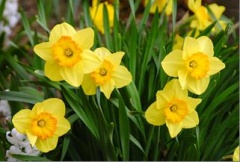Daffodil
| Infobox on Daffodil | |
|---|---|
| Example of Daffodil |  |
| Facts | |
| Origin | - |
| Stowage factor (in m3/t) | - |
| Humidity / moisture | - |
| Ventilation | - |
| Risk factors | See text |
Daffodil
Contents
Description / Shipment / Storage / Risk factors
Scientific Name and Introduction
Narcissus cvs. Daffodils, symbols of Spring and known for their bright yellow, orange, red, pink, and white colours, are garden favourites world-wide. Unfortunately, these flowers have relatively short vase lives that cannot as yet be increased substantially with standard postharvest treatments. Narcissus is a classical Latin name, from the Greek; perhaps as the origin suggests, an allusion to narcotic properties. It is not clear whether it was named after the youth Narcissus in mythology.
Quality Characteristics and Criteria
Daffodils are normally harvested at the "goose-neck" stage. Jonquils are often harvested at the "one bell" stage, when only one flower is open on the spike. Harvesting is normally done by cutting the flower from the foliage and bulb, although the whole plant may be removed and the bulb and leaves then cut from the flower spike. Flowers should be purchased in the pencil to gooseneck stages. These terms refer to flower position relative to the stem; pencil being straight up and gooseneck bent downwards to about a 45°C angle.
Grading and Bunching
As with a number of other "spike"-type flowers, narcissus will bend upwards away from gravity if laid down flat. For this reason flowers should be kept vertical when they are not cooled to the proper storage temperature. Although there are no formal grade standards for these flowers, the most important quality attributes are maturity, uniformity of colour, and freedom from damage or disease. Flowers are normally bunched in groups of 10 or 25, tied with twistems and sleeved in paper or plastic.
Ethylene Sensitivity
Senescence of these flowers is accelerated by exposure to ethylene, although their natural senescence does not involve ethylene. Pretreatment with 1-MCP or STS may extend flower life where flowers are handled in ethylene-polluted environments such as mass market outlets.
Pretreatments
Pretreatment with 1-MCP or STS can help extend vase-life of flowers that are likely to be exposed to ethylene.
Storage Conditions
Store daffodils and jonquils at 0°C to 1ºC. Store upright as these flowers will bend upwards from gravity. Narcissus can be stored at 1ºC and 90% RH for up to 2 weeks with only slight reduction in vase-life. They may also be stored for several weeks in an atmosphere of 100% N2. Narcissus stored in this way have as long a vase-life as fresh cut flowers and nearly double the vase-life of air-stored flowers. Flowers are best stored upright and dry, in containers that permit rapid cooling of the flowers, e.g., in fibreboard boxes.
Packing
Because of their sensitivity to gravity, daffodils are often packed in hampers, although they may be packed in horizontal fibreboard boxes if they are properly pre-cooled and maintained at the correct storage temperature.
Special Considerations
Daffodils exude a gelatinous (slimy) substance that, when transferred through a common holding solution to other flowers like tulips and anemone, can result in premature death for the other flowers. Therefore, place freshly cut or re-cut flowers into a separate holding bucket for a few hours. Later they can be placed with other flowers and used (even re-cut if required) in arrangements without affecting the life of the other flowers.
Sources used
BMT Consolidated Manual on (Dutch) Flower Bulbs, cut flowers/greens and potted plants.











